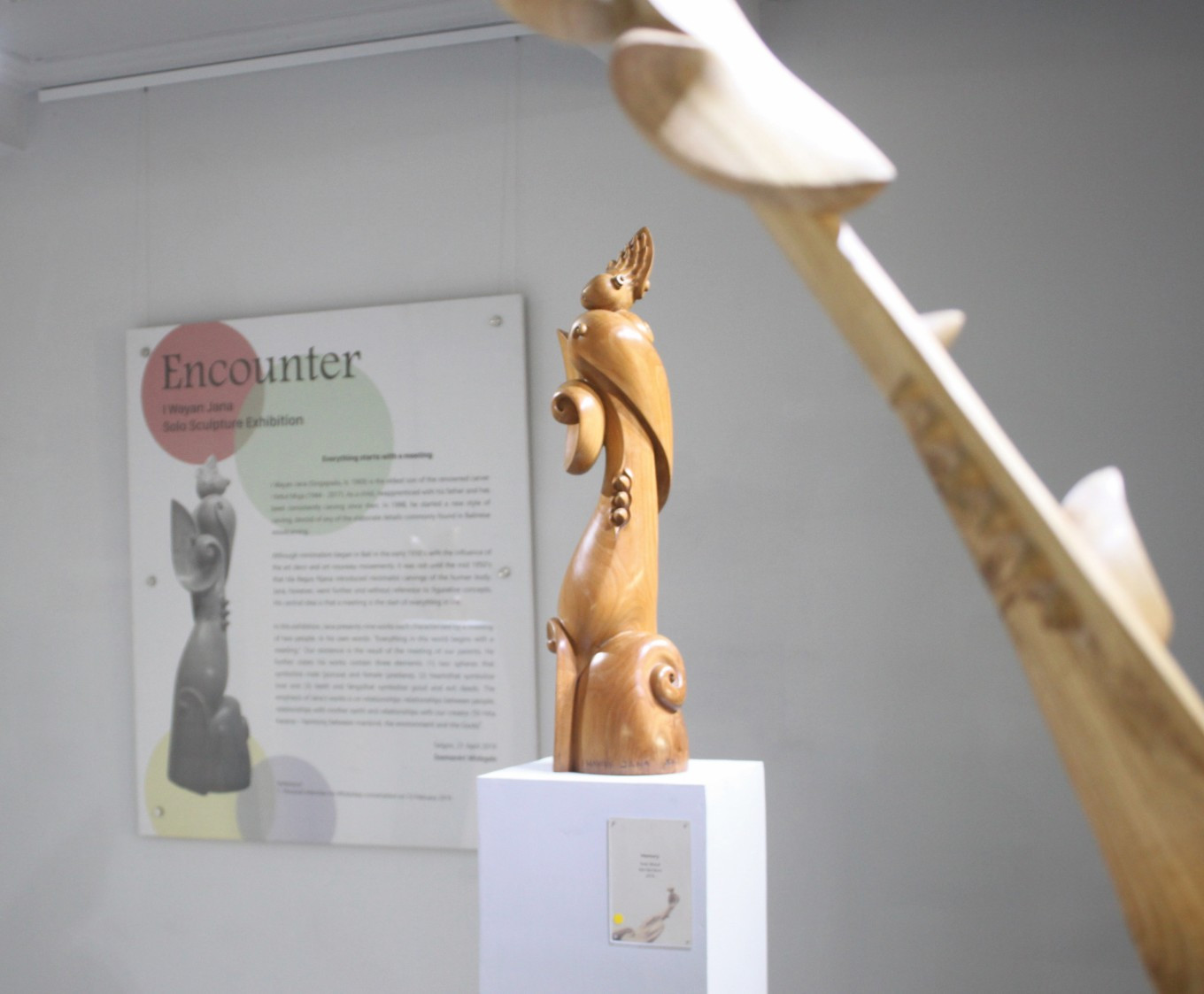Popular Reads
Top Results
Can't find what you're looking for?
View all search resultsPopular Reads
Top Results
Can't find what you're looking for?
View all search resultsWayan Jana presents new directions in Balinese woodcarving
“Everything in this world begins with a meeting,” states Jana in the exhibition catalog. Born in Singapadu, Gianyar, in 1969, Jana is the eldest son of I Ketut Muja and from a young age he apprenticed with his father and has been carving ever since.
Change text size
Gift Premium Articles
to Anyone
B
alinese woodcarving has evolved during the past century with distinct stylistic developments marked its transition from the traditional genre to the modern and contemporary. Iconic figures Tjokot, Nyana, Tilem and Muja defined the landmark styles that have become the source of inspiration that many have followed.
Although minimalist adaptations to woodcarving began in Bali in the early 1930’s with the influence of the Art Deco and Art Nouveau movements, the key pioneers being I Rodja and I Geremboeang from the famous woodcarving village of Mas, it was not until the mid 1950’s that Ida Bagus Nyana (1912-1985) also from Mas, introduced minimalist carvings of the human body.
The major progressions that reveal the development of woodcarving are by I Tagelan (1902-1935) who produced an elongated composition of a woman in the mid-1920’s from a long piece of wood given to him by Walter Spies who originally requested he produce two statues.
I Tjokot (1886-1971) gained his reputation in the late 1920’s for utilizing timber’s natural expressive qualities and creating grotesque figures exploiting the dark side of Balinese mythology with his tough carving style.
Nyana experimented with mass, carving human characters shortening some parts of the body and lengthening others, creating plump forms with serene facial expressions. His son Ida Bagus Tilem (1936 -1993) furthered both Nyana’s and Tjokot's innovations adopting abstract themes with philosophical or psychological content using distorted pieces of wood endowed with strong expressive powers.
I Ketut Muja (1944-2014) made his initial statement with his interpretations of the Hindu god Hanuman, meticulously and delicately sculpting the monkey’s fur. He then went further by carving frightening figures that brought out the soul of the wood along with his own emotions and state of mind.
The lack of attention from museums and galleries toward contemporary woodcarving recently has resulted in the genre being overshadowed by painters and other artists working in new sculptural media.
Encounters, an exhibition of nine works by I Wayan Jana, opens on May 11 at TiTian Art Space in Ubud, revealing the wonderful potential of the medium when inspiration meets remarkable creative ability. The emphasis of Jana’s works is upon relationships: relationships between people, relationships with mother earth and relationships with our creator.
In Encounter each of Jana’s compositions are characterized by a meeting of two people and taking the form of fascinating and unusual abstractions of the pairing of two figurative forms. “Everything in this world begins with a meeting,” states Jana in the exhibition catalog.
Read also: Balinese artists showcase collective spirit
Born in Singapadu, Gianyar in 1969, Jana is the eldest son of I Ketut Muja and from a young age he apprenticed with his father and has been consistently carving ever since. In 1998, he started a new style of sculpture, devoid of the elaborate and extravagant details commonly found in the Balinese Baroque woodcarving tradition.
Spheres and series of protruding spikes, circular swollen shapes, jutting forms and strange appendage-like things, hearts, heads and tails, Jana’s imagination brings to life creations that are always organic, yet at once otherworldly. Nurtured and delightful outcomes of his inspirational themes that even include the Hindu gods.
"Penyejuk Jiwa" (Soul Oasis), 2019, 41 by 36 by 27 centimeters is arguably Jana’s most abstract work within Encounters, the artist’s fourth solo exhibition to date. A reclining form is propped upright by two limbs, and is highlighted by another that is pointing toward the sky. Collectively they appear as a grouping of wings or fans blades that instantly stimulate our imagination.
"Penyejuk Jiwa" is seemingly propelled upward and may be seen ascending within the mind's eye - according to Jana, the composition is inspired by peace and harmony of an adoring couple.
While the gently curving shapes of "Deringan Rindu" (Longing), 2019 and "Gairah Dara" (Virgin Lust), 2019, take the form of elongated vehicles that we may envision traversing the oceans or zooming across the skies, "Sehati" (Soul Mate), 2019 and "Sayang Menyayangi" (Compassion), 2019 take on different proportions. Both appear immediately grounding, and aesthetically calming via the soul of timber’s spiraling and flowing grains, and the sculptures' bulbous, full designs.
"Irama Hati" (Heart Rhythm), 2015, dimensions 36 by 9 by 38 cm is the artist’s oldest work. At a glance it evokes an image of the seated form of the master Balinese dancer Ketut Marya, famously known as Mario, executing the Kebyar duduk, first created and performed in 1925. One delicate raised limb suggests Mario holding a fan, an essential visual element of the dance along with his body’s dynamic rotating rhythm.
Jana further explains in the catalog that his works contain three elements: (1) two spheres that symbolize male (purusa) and female (predana), (2) hearts that symbolize love and (3) teeth and fangs that symbolize good and evil deeds.
“In developing these forms I have certainly gone through many creative stages,” said Jana, who received his Bachelor of Fine Arts from the Indonesian Institute of Art (ISI), Denpasar.
“After a number of experiments I then found the concept of ‘the meeting’ that is the origin of life and of all living things on earth.”
“What motivates me is my search for my own distinct identity and style. This idea is present in the artists who already have their own work identity. Like Tjokot, Nyana, Tilem and Muja. Each style has its own unique characteristics,” he stated, and continued. “I want to be like my predecessors, with my sculptures having their own individual characteristic, namely the Jana style.”
“Jana is the first contemporary wood carver that TiTian has honored with a solo exhibition,” said the Yayasan TiTian chair of the board of advisors Soemantri Widadgo. “He has introduced a new style and a marked departure from anything before him, including his own father. I believe he has the potential to be the next recognized master of Balinese woodcarving.”
_______
Encounter continues through June 6
Open daily 9 am – 5 pm (except Mondays)
at TiTian Art Space, Jalan Bisma 86, Ubud, Gianyar, Bali
www.titianartspace.com











